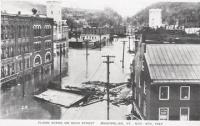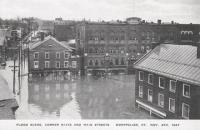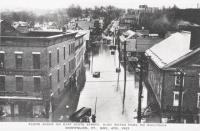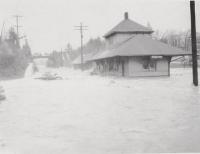
Serving the Vermont Champlain Valley Area for 45 Years
Main SectionsFront Page SportsValley VitalsIt's in the StarsStarwiseArchivesLinksAbout The VoiceContact Us |
When Rivers Became A Torrent: Remembering The Flood Of 1927Tuesday March 22, 2011 By Cookie Steponaitis While spring rains bring a welcome relief and a change of seasons and Vermonters watch the snowcaps melt and the rivers swell, there are times when the rivers overflow and Vermont experiences the full power of a spring flood. Such was the case in 1927. While there had been record rains that year, no one expected the two days in November that would bring downpours and send Vermont Rivers over their banks in several Vermont cities and towns. While the rain was heavy no one moved the state to emergency status until early in the afternoon of November 3rd, 1927 when the Weather Bureau announced that the rains would persist for the next thirty hours and the rivers would continue to rise. During the night word spread through telegraphs and telephones that many towns were facing the full force of the rivers and thousands were being evacuated during the night. Closer to Burlington, the Winooski, Lamoille and Missiquoi Rivers were overflowing their banks into fields and the debris showed the devastation occurring downstream. Mobilized by the governor, a combination of World War I veterans and Vermont cavalry men started up the rivers to see what was amounting to a growing disaster. Immediate contact to Washington, D.C. had President Calvin Coolidge contributing to the effort by sending planes to fly over the region. Where roads were impassable and almost indistinguishable, markers were placed that identified solid objects and made paths for boats to navigate by. One of the first noticeable crop casualties were thousands of Christmas trees that had stood ready to be harvested for the coming season. Many parts of the Central Valley Railway lost hundreds of miles of track and rails, fences and railroad ties were tossed like toys and thrown around the landscape. The force of the waters in Bolton met up with the narrow gorge and actually created a huge hole in the side of the mountain. Stacked up at points along the river were jumbles of partitions, furniture, cars and carcasses of livestock. One of the hardest hit communities was Montpelier and by the afternoon of November 3rd, businesses were under water and with night falling, the magnitude of the flood was increasing. During the cover of that night Montpelier experienced its worst natural disaster to date. While history documents countless acts of courage and support, men on rafts saving materials and stranded citizens, the city lost power and waited for light to assess the damage. Many people were caught away from their homes and there was a lack of knowledge by many if people were dead or simply missing. As the morning sun peaked through the clearing rain clouds, some of the scenes that greeted people were testimony to the power of the water and the unusual nature of who and what survived. Eyewitness testimony from the Montpelier area recorded, “Several boxes of eggs floated down the main street on a pocket of sawdust unbroken. In one wet home was the strange partnership of a cow eating grass and a marble statue. A horse thought drowned appeared in the second story of a home and a small intact barn washed downstream and landed on the bank replacing one that the water had swept away.” Adding to the confusion was that fact that several newspapers were completely underwater. The Montpelier Argus was unable to publish and the St. Johnsbury Caledonian only could print one sheet. The St. Albans Messenger produced some newspapers that were handed out at local gas stations. With a total impact of displacing 9,000 or more Vermonters and an additional 18,000 damaged homes and properties, Vermont had to reach out and seek help from the Federal government. Assistance came in from other New England states and even school children collected donations to send to Vermont communities. Since it was technically still winter, repairs were hampered by additional cold, weather and ice. The first functioning railroad transportation resumed on February 4, 1928. The official death toll was listed at 84 across the state and damages ran into the millions including bridges and roads over seven million and farms at over one million dollars. Industry repairs were over seven million and village and property damages totaled over six million. The resiliency of the Vermont people and their community ethics brought Vermont back to being commercially successful and moving forward with pride and dedication. Captured on film by many people who survived the event and those who covered the damage to their homes and Vermont, the archives hold testament to the time when Vermont was the focus of the nation’s attention and the crisis was faced with the calm Vermont matter of fact statement expressed by many in the state’s capital, “We’ll take care of things.”
|
AdvertisementsSearch our Archives |
Agricultural Weather Forecast:

© 2006-18 The Valley Voice • 656 Exchange St., Middlebury, VT 05753 • 802-388-6366 • 802-388-6368 (fax)
Valleywides: [email protected] • Classifieds: [email protected] • Info: [email protected]




 Printer Friendly
Printer Friendly